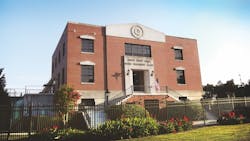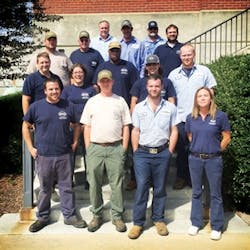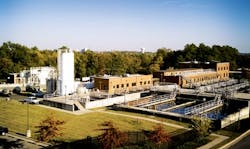Data Dissection
The Orange Water and Sewer Authority (OWASA) in Carrboro, N.C., has increased the maximum capacity of its Jones Ferry Road Water Treatment Plant five-fold in almost 40 years, and since 2011 it has been among the most consistent facilities in the country.
OWASA joined the Partnership for Safe Water in 2002, and has used the organization to heighten its standards and optimize its processes. Doing so required all facility staff members to embrace the methods for improvement. This earned OWASA the Phase IV Excellence in Water Treatment Award in 2011, and in 2015, the partnership recognized the plant with the 10-Year Directors Award.
“Part of the partnership itself is to strive for confidence and consistent improvement,” said Ken Loflin, water supply and treatment manager for OWASA. “Part of the partnership program is a self-evaluation, so once we got the Directors Award—that was part of going through that self-assessment—[we started] looking for ways to improve the processes, maintaining the plant, stuff along those lines, and, of course, getting buy-in from upper management, from the operators.”
Although there have been changes in technology and some equipment upgrades over the years, few of OWASA’s optimization improvements have come from major upgrades. In fact, most of the efficiency has been the result of data analysis and internal evaluation. It is that reflection that lies at the heart of OWASA’s success.
“Some of it is just trial and error,” Loflin said. “[We look] at how our equipment works, what we did in the past, what worked, what didn’t work.”
All employees have input and buy into the plant’s vision.
Train of Treatment
OWASA, a publicly owned nonprofit, was formed in 1977, 29 years after the plant was built by the University of North Carolina. The facility has grown to include a conventional treatment plant with two treatment trains as well as sediment basins with two upflow pulsators. Water and sewer rates are the financial foundation for those improvements.
“[Around 2007 or 2008], we had three years of 17% increases in a row, but on the other side of that, in the past five years, we’ve had 0% increases on our water and sewer rates,” Loflin said. “The good thing about [rate-structured finances] is all the money that comes in gets put back into the infrastructure, back to the water, wastewater and sewer pipes in the ground.”
Raw water from three watersheds—University Lake (450 million gal), Cane Creek Reservoir (3 billion gal) and Stone Quarry (200 million gal)—is pumped to the head of the treatment plant, where it mixes with ferric sulfate, a primary coagulant first used at the facility in March 2014.
“To maintain our [total organic carbon] removal, we looked at ferric [sulfate],” Loflin said, “and a lot of our neighboring utilities had moved to ferric [sulfate].” The switch paid off, as it led to a 50% reduction in disinfection byproducts at the plant.
Potassium permanganate is used at the head of the plant as well, before the water enters the flash mix, which can be manually controlled by operators. Then 10 dual-media gravity filters with anthracite and sand filter the water before pH is tested, and fluoride and a corrosion inhibitor are added. As the water enters the pump to the distribution system, it is disinfected with chloramines.
OWASA continually makes concerted efforts toward greater efficiencies.
Strive to Optimize
The relationship with Partnership for Safe Water has instilled a sense of pride in plant staff, while also empowering them to make key decisions on process optimization. In the summer, for instance, North Carolina had a tremendous rainy season that made operations difficult for operators.
“You actually got to see that put into effect—how seriously they took the partnership goals even when they faced challenges,” Loflin said. “They take it seriously and it’s been instilled in them to achieve a higher level of commitment in the treatment process.”
Before the plant achieved Phase IV in 2011, Loflin said it had a single turbidometer to monitor its processes. As the plant pushed for improvements, it added turbidometers to every pulsator and sediment basin in the process. “You get an idea [that] one basin was different from another one and producing a different turbity,” he said. “So you learn a lot about how your plant works that you never really looked at before. That’s part of that data, looking at it and being able to analyze it.” That data, he added, then is used to evaluate next steps for the plant.
No Slowing Down
OWASA does not intend to rest on its laurels after receiving the 10-year Directors Award. It already has a plan in motion to improve energy efficiency through increased monitoring, and operators are taking a proactive stance on future regulations. Loflin said trying to stay a step ahead of regulatory action is beneficial, adding that he and operators have been reviewing the Unregulated Contaminant Monitoring Rule 3 for that purpose.
Chlorate was one contaminant OWASA’s data-driven analysis tracked and changed. Operations supervisor Monica Dodson said OWASA staff researched the contaminant and conducted plant studies. Dodson said the degradation of sodium hypochlorite contributed to the formation of chlorate, and after reducing storage times of the hypochlorite, chlorate was reduced by 72%. Such a change would not have been possible without careful study.
“Collecting that data—keeping it, trending it and tracking it—and using that is a beneficial way to know what’s happening within your facility—it is really key and important,” Loflin said.


